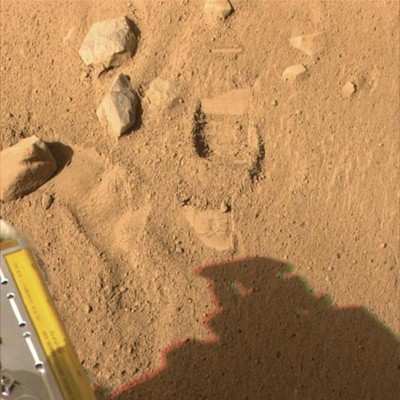Odyssey Orbiter Issue Delays First Scientific Dig
Two practice rounds of digging and dumping the clumpy soil at
the Martian arctic site this week gave scientists and engineers
gathered at the University of Arizona confidence to begin using
Phoenix's Robotic Arm to deliver soil samples to instruments on the
lander deck.

Those samples will not be collected before Thursday, however.
Following Wednesday’s briefing on the mission, the Phoenix
team learned NASA's Odyssey orbiter, which relays Phoenix data to
and from Earth, had entered a "safe mode," preventing Wednesday's
(or sol 10) instructions from reaching the lander. Instead, Phoenix
will complete a sequence of commands that are already stored on
board. That sequence includes instructions for the lander to
continue taking images required to assemble a full-color 360-degree
high-resolution panorama.
Odyssey mission managers are doing a check out of the orbiter to
determine what triggered the safe mode. During safe mode, the
spacecraft turns off non-essential operations and waits for
instructions from Earth. In the meantime, the Phoenix team has been
directed to issue commands to the lander and receive data through
Mars Reconnaissance Orbiter (MRO). While Phoenix has been primarily
utilizing Odyssey for relay services since MRO's UHF radio
unexpectedly powered off during a relay pass on Sol 2, the radio
has been exercised repeatedly over the past week and appears to be
operating well.
The two practice digs have already enticed scientists about some
bright material in the soil just beneath the surface.
"Two scoops into the soil we see there's a white layer becoming
visible in the wall of the trench," said Carol Stoker of NASA Ames
Research Center, Moffett Field, CA, a member of the Phoenix science
team.

Phoenix Principal Investigator Peter Smith added, "We've had an
impassioned discussion of whether that may be salts or ice or some
other material even more exotic."
Concentrations of salts can be indicators of formerly wet
conditions. One goal for the Phoenix mission is to determine
whether the ice beneath the surface of far-northern Mars ever thaws
during long-term climate cycles.
The location chosen for the sample is adjacent to the hole dug
by the two practice scoops. The team plans to command the arm to
deliver the sample to the lander's Thermal and Evolved-Gas Analyzer
(TEGA), after it first receives images to confirm that the scoop
holds collected soil ready for delivery.
"The arm has been performing flawlessly," said Ashitey
Trebi-Ollennu of NASA's Jet Propulsion Laboratory, senior robotics
engineer on the Phoenix Robotic Arm team. The arm made daring, Tai
Chi or Yoga-like moves to position the Robotic Arm Camera to take
pictures underneath the lander, and did its two test digs
"magnificently," he said.

Phoenix is the first mission to dig into Mars with a robotic arm
since the Viking landers in the 1970s. "We have only dug to a depth
of an inch or two, so we know there are challenges ahead,"
Trebi-Ollennu added. "But we are confident that we'll get a good
amount of material to deliver to TEGA."
 ANN's Daily Aero-Term (04.25.24): Airport Rotating Beacon
ANN's Daily Aero-Term (04.25.24): Airport Rotating Beacon ANN's Daily Aero-Linx (04.25.24)
ANN's Daily Aero-Linx (04.25.24) Klyde Morris (04.22.24)
Klyde Morris (04.22.24) Airborne 04.24.24: INTEGRAL E, Elixir USA, M700 RVSM
Airborne 04.24.24: INTEGRAL E, Elixir USA, M700 RVSM Airborne 04.22.24: Rotor X Worsens, Airport Fees 4 FNB?, USMC Drone Pilot
Airborne 04.22.24: Rotor X Worsens, Airport Fees 4 FNB?, USMC Drone Pilot





